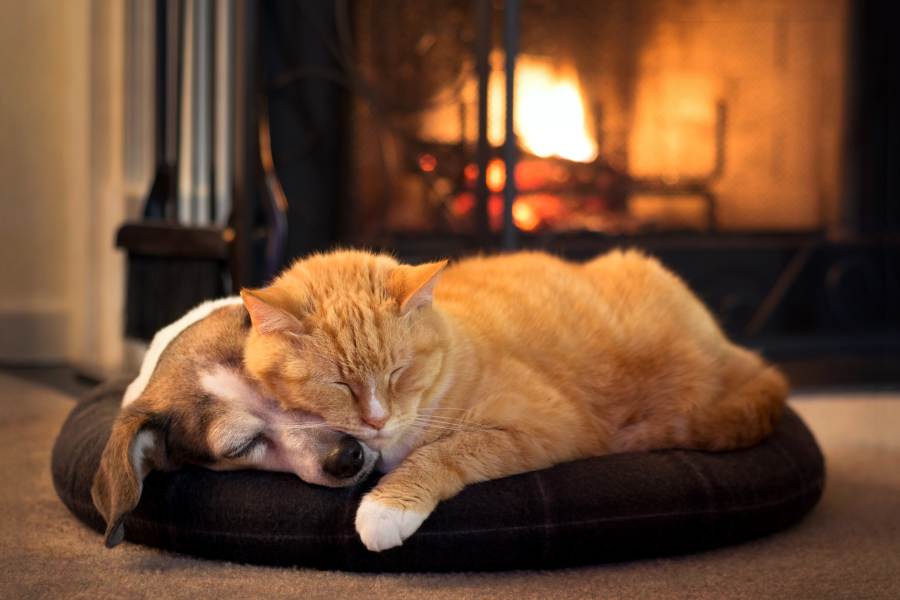In the midst of December, as Hong Kong welcomes the arrival of a cold front, temperatures can plummet to a minimum of 12 degrees Celsius. This sudden and bitter cold weather not only challenges the endurance of humans but also affects our beloved furry companions. In order to safeguard our cats and dogs from the chilling temperatures, here are five tips for keeping them warm.
9 Signs Your Pet Could Be Feeling Cold
With the exception of a few breeds such as hairless cats, most domestic feline and canine companions are adorned with a luxurious coat of fur, which generally provides them with better insulation against the cold compared to humans. However, it is worth noting that the normal body temperature of cats and dogs hovers around 38-39℃, slightly higher than that of humans. Therefore, when faced with chilly weather, our beloved furry friends may perceive a greater disparity in temperature than we do, making them susceptible to feeling cold. This is particularly true for young, elderly, small-sized, or those with cardiovascular ailments, whose bodily functions may be compromised, necessitating additional measures to ensure their warmth.
When dogs and cats exhibit the following behaviors, there is a likelihood that they are experiencing the sensations of coldness:
- Their bodies curl up.
- Their bodies tremble.
- Their joints become stiff and rigid.
- Their paws and hands turn icy cold.
- Their ears feel cold to the touch.
- They seek solace by clinging to their owners or companions.
- They appear absent-minded or less energetic.
- They exhibit an increase in sleeping duration.
- They have a runny nose.

5 Tips to Keep Your Pet Warm in Winter
- Mats or Blankets
Mats or cozy blankets serve as the simplest, safest, and most effective means of providing warmth for our cherished feline and canine companions. By placing these woolen mats or blankets in the areas where our pets usually engage in their daily activities, they will naturally seek refuge upon them, finding solace and respite while basking in their gentle embrace. - Heated Mats or Stoves
Heated mats or stoves are favored by many households during the cold winter season for their rapid and efficient warmth. However, it is imperative for pet owners to exercise caution, as these items carry inherent risks. Maintaining a safe distance between the heating stove and dogs and cats is essential, while placing a thick towel on the heated mat helps prevent any accidental burns. Furthermore, it is crucial to ensure that our pets have unrestricted movement, enabling them to approach the heated mat or stove at their own discretion and wander away if they feel overheated. Under no circumstances should our precious pets be confined in cages while exposed to heating mats, stoves, or blowers, as this may lead to heatstroke or burns. - Warm Water
Offering dogs and cats lukewarm water at approximately 25-30 degrees Celsius not only provides them with a comforting source of warmth but also encourages hydration. Nevertheless, it is crucial to refrain from providing hot water directly, as this may result in accidental scalding. - Stay Indoor
While dogs typically enjoy their walks, it is advisable to limit their outdoor excursions or consider indoor activities when the biting cold winds prevail. Cats, on the other hand, naturally have lesser inclination for outdoor ventures and should be kept indoors during the cold winter months. - Clothes
Adorning our feline and canine companions with clothing akin to that of humans can indeed provide warmth, but it is important to note that not all cats and dogs may appreciate such attire. Pet owners must exercise discretion when selecting garments for their furry friends. The protective clothing for cats and dogs should cover their bellies and be made of comfortable, breathable materials, ensuring that excessive thickness does not impede their mobility. Overdressing our pets with excessive layers may lead to heatstroke, while prolonged periods of wearing clothes could potentially cause skin issues. It is crucial to refrain from attaching heat packs to their clothing, as prolonged and direct contact may result in chronic burns for our beloved feline and canine companions.
The cold resistance capabilities of cats and dogs vary depending on their breed and physique. Certain long-haired breeds and those naturally adapted to colder climates, such as sled dogs or Samoyeds, may find cooler weather more comfortable. Therefore, it is important for owners not to blindly attempt to keep their feline and canine companions warm but rather to first understand their individual needs before taking any action.
About PET-A-HOOD
Our platform is a one-stop destination for the latest and the most comprehensive pet-related information. From helping you discover pet-friendly businesses nearby, to planning fun weekend activities, we are your trusted partner when it comes to curating a healthy and exciting lifestyle for your pet friends and you. We also encourage pet owners to build their Pet’s Social Community through Pet-a-hood, by exchanging pet-caring experience, pet-related news, and connecting with other pet lovers in the neighbourhood.




